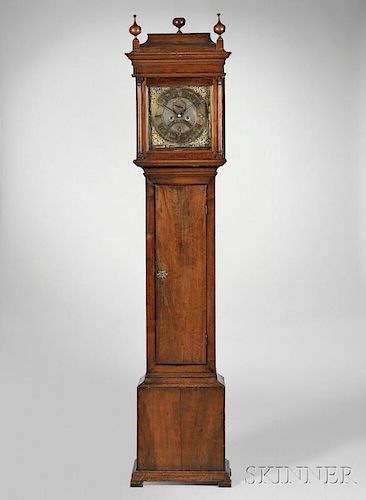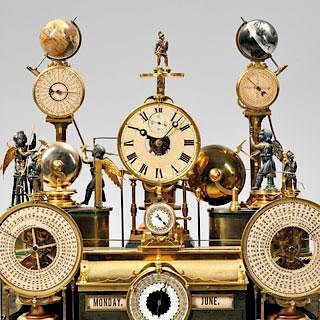John Wood Sr. Walnut Eight-day Tall Clock
Lot 120
About Seller
Bonhams Skinner
274 Cedar Hill Street
Marlborough, MA 01752
United States
Founded over four decades ago, Bonhams Skinner offers more than 60 auctions annually. Bonhams Skinner auctions reach an international audience and showcase the unique, rare, and beautiful in dozens of categories, including the fine and decorative arts, jewelry, modern design, musical instruments, sc...Read more
Categories
Estimate:
$20,000 - $40,000
Absentee vs Live bid
Two ways to bid:
- Leave a max absentee bid and the platform will bid on your behalf up to your maximum bid during the live auction.
- Bid live during the auction and your bids will be submitted real-time to the auctioneer.
Bid Increments
| Price | Bid Increment |
|---|---|
| $0 | $10 |
| $100 | $25 |
| $500 | $50 |
| $1,000 | $100 |
| $3,000 | $250 |
| $5,000 | $500 |
| $10,000 | $1,000 |
| $30,000 | $2,500 |
| $50,000 | $5,000 |
| $100,000 | $10,000 |
| $300,000 | $25,000 |
| $500,000 | $50,000 |
| $1,000,000 | $100,000 |
About Auction
By Bonhams Skinner
Apr 29, 2016 - Apr 30, 2016
Set Reminder
2016-04-29 10:00:00
2016-04-30 10:00:00
America/New_York
Bidsquare
Bidsquare : Clocks, Watches & Scientific Instruments
https://www.bidsquare.com/auctions/skinner/clocks-watches-scientific-instruments-1417
Bonhams Skinner bidsquare@bonhamsskinner.com
Bonhams Skinner bidsquare@bonhamsskinner.com
- Lot Description
John Wood Sr. Walnut Eight-day Tall Clock, Stretch's Corner Philadelphia, Pennsylvania, c. 1720, the sarcophagus top with three ball finials resting on a flat molded top cornice over the glazed hood door with engaged columns, composite brass dial signed on the maker's boss John Wood/Philadelphia, Roman numeral chapter ring with half and quarter-hour markings, seconds bit, recessed date dial, ringed winding holes and cast brass spandrels, replacement hands, figured walnut rectangular waist door over the raised plinth and molded flat base, eight-day time and hour strike movement with founder's mark "A" engraved on back plate, four ring-decorated pillars, recoil escapement, top mounted bell, and count wheel strike component attached to the great wheel all regulated by a period pendulum, two period lead weights and original winding key, ht. 94 in.
Note: American domestic clocks from the first half of the 18th century are extremely rare. In the bustling colonial center of Philadelphia, John Wood Sr. was among the earliest of a small group, which included Peter Stretch. Stretch's clocks and work are comprehensively detailed in Donald L. Fennimore and Frank L. Hohmann, III, Stretch, America's First Family of Clockmakers. This study documents nearly identical work with Stretch's square dial examples to that of John Wood Sr., all showing the similar hand in the ring-decorated pillars, escapements and count wheel strike system; Fennimore and Hohmann, pp. 132-163.
Estimate $20,000-40,000
All hands in need of replacement, dial has been fastened to a 1/4-in. strip of brass on all sides to provide security from bending, replacement walnut seating board, movement wants overhaul, bell appears to be from a 19th century Japanese clock, center final top removed to fit into lower ceiling height and replaced with a removeable 'flag pole' eagle not shown in photograph, sarphagus top possibly had one more return although remains of original roof boards remain, later "pad" feet are easily removeable, later bottom board, dial components no doubt were originally silvered, some remains exist on date dial, period lead weights, brass pulleys, pendulum and winding key. With professional conservation/restoration, this could be a stunning example of early clock making from an important colonial center.
The absence of a condition statement does not imply that the lot is in perfect condition or completely free from wear and tear, imperfections or the effects of aging. Condition requests can be obtained via email (lot inquiry button) or by telephone to the appropriate gallery location (Boston/617.350.5400 or Marlborough/508.970.3000). Any condition statement given, as a courtesy to a client, is only an opinion and should not be treated as a statement of fact. Skinner Inc. shall have no responsibility for any error or omission. - Shipping Info
-
Please visit http://www.skinnerinc.com/services/payment-and-shipping/ for information regarding the collection of items purchased at auction.
-
- Buyer's Premium



 EUR
EUR CAD
CAD AUD
AUD GBP
GBP MXN
MXN HKD
HKD CNY
CNY MYR
MYR SEK
SEK SGD
SGD CHF
CHF THB
THB













